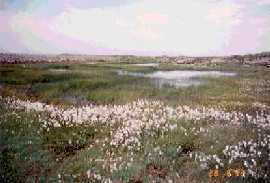The landscape of Central Inishowen is mostly moorland comprised of blanket bog. The bogland forms as a result of the wet climate near the Atlantic coast and this landscape is seen all along the west of Ireland. The acid conditions in bogland prevent the proper decay of plant debris and this debris builds up as a layer of peat. In many places where the peat has been dug out for fuel, old stumps and roots of trees can be seen which are from the time before the bogs formed, when the climate was dryer about five or six thousand years ago.
Today there are large areas of forestry planted by the state forestry body, coilte, for commercial use. These trees are chosen for quick growth and are planted close to achieve tall and straight growth. Because of this tightly packed planting there is not much wildlife in the mature forest areas but when the trees are young there is more space for other plants and good nesting sites for birds.
The plants that mainly form the peat are mosses especially Spagnum mosses which grow everwhere on the moorland. Heather is a more visible plant of which there are three species. In early summer Bell Heather and Cross Leaved Heath are in bloom, notice that these two species grow close by each other but the first is always on dryer patches while the second is on the wetter ground. The heather that blooms in late summer is Ling.
An interesting plant that grows in wet areas is the Sundew. This small plant is remarkable in that it supplements the lack of nutrients in the bog by consuming small insects. It has a sticky substance on it's leaves which trap small insects and flies over which the leaves slowly curl and absorb the unfortunate creatures.
Other plants particular to this bogland habitat are Bog Aspodel, a spiky yellow flower and Bog Cotton, which grows in white drifts in the summer.Charr have recently been discovered in Lough Fad, the lower of the two lakes in the moorland between Buncrana and Carndonagh. These fish, like their relatives the Salmon, at one time migrated to sea (and still do in Scandinavia) but at the end of the last ice-age populations were cut off from the sea and many similar lakes around Ireland hold these fish.


Birds that are found on the moorland include the Raven which is the largest of the crow family. The Merlin is the smallest falcon in Ireland. It's favorite prey, the Meadow Pipit is probably the most common moorland bird. Red Grouse are exclusively moorland birds that feed mainly on young heather. Old heather is often burned to encourage the growth of new heather to help increase populations of these birds. In many areas of moorland you can hear the Skylark singing as it soars high in the sky. Other birds here are Stonechat and a summer visitor, the Wheatear.
